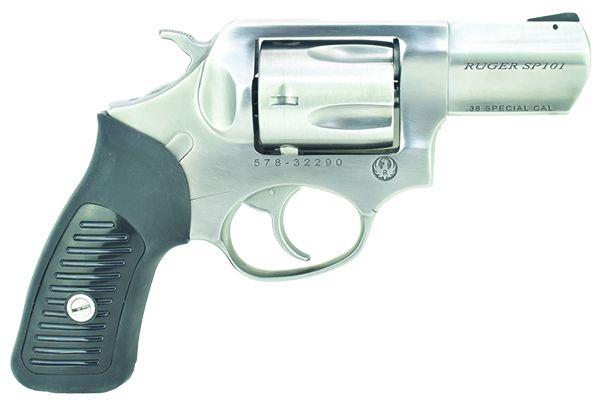Once widely maligned as “Tupperware,” the polymer pistol now rules the shooting world to the point where the writer of this article, who is also a very active trainer and LTC instructor, has many students say they’ve never shot an all-metal handgun. And some are also not personally familiar with the revolver, regardless of composition. So, our Houston testers wondered if the 38 Special wheelgun is practically dead, or can it still serve a useful purpose as a viable every-day carry handgun when so many good semi-automatic 9mm pistols exist.
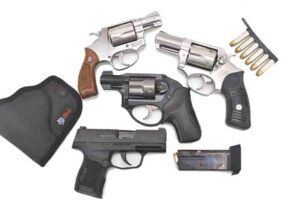
To find out, we chose the SIG Sauer P365, perhaps the hottest-selling handgun in this country, as a benchmark against which to compare some new and not-so-new revolvers. The baseline we tested against was a SIG P365 365-9-BXR3 9mm Luger, $599. As a value proposition, we started off the revolver part of the tests with an older S&W Model 60 38 Special, $459. The closest modern equivalent of the 1978-version Model 60 is a blued Model 36 150184 38 Special, $809. Next, we included a Ruger LCR 5401 38 Special +P, $699. Last was a Ruger SP101 5737 38 Special, $859. Someday, the ammo drought will end, but because we’re not there yet we once again used properly assembled reloads for the revolvers. We tried to get a little extra speed with those short barrels, so we used 125-grain bullets. The first we tried was Hunter’s Supply hard-cast lead flat point from MidwayUSA.com (418579, $15/100). We also shot Hornady’s 125-grain XTP (490514, $24/100). For the SIG P365 9mm, we used SIG Sauer’s 115-grain V-Crown (MidwayUSA.com 966280, $22.50/20) and 9mm Remington Range ammo (542116, $30/50).
Keeping in the mind the assumed use of these handguns was for self defense, accuracy testing was done at 7 yards. Even though two of the three revolvers allowed single-action shooting, all testing for accuracy and speed was performed double action only. Group shooting consisted of multiple five-shot strings fired from a well-weighted Caldwell Pistolero shooting rest (MidwayUSA.com 562771, $30). Muzzle velocities were obtained via a LabRadar chronograph. All shooting was done at American Shooting Centers in west Houston. Here’s how the handguns performed.
Gun Tests Grade: B-
$859
Introduced in 1989 and redesigned more than a decade later, the SP101 was brought to market as a replacement for the Security Six. While this is still considered a small-frame five-shot revolver, it is considerably larger and heavier than the LCR. The construction is solid stainless steel, and like the LCR, the fire-control unit comes as a group, with no side plate and no individual small parts. That can also make it more difficult to do a trigger job on the SP101, and our factory unit was a bit heavy with some stacking.
| Action Type | Double-action and single-action revolver |
| Overall Length | 7.25 in. |
| Overall Height | 4.7 in. |
| Maximum Width | 1.35 in. |
| Weight Unloaded | 1.62 lbs. |
| Weight Loaded | 1.69 lbs. |
| Receiver | Brushed stainless steel |
| Front Strap Height | 2.0 in. |
| Back Strap Height | 3.6 in. |
| Barrel Length | 2.25 in. |
| Grip Thickness (Maximum) | 1.3 in. |
| Grip Circumference | 4.5 in. |
| Cylinder Capacity | 5 rounds |
| Front Sight | Replaceable fixed serrated ramp |
| Rear Sight | Groove in top strap |
| Sight Radius | 4.0 in. |
| Trigger Pull Weight (Double Action) | 12+ lbs. |
| Trigger Span | 2.9 in. |
| Safety | Rebounding hammer with transfer bar |
| Warranty | None listed |
| Telephone | (336) 949-5200 |
| Made In | USA, NH |
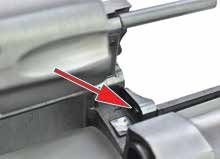
The bottom of the FCU ends in a stud to which is attached a one-piece grip. The grips do have plastic panels in them, but it is still a single unit that is very easy to replace if desired. In contrast to our other two revolvers, this grip is long enough to actually get part of the little finger on it, allowing a bit better control under recoil. With this SP101 weighing in at 26 ounces versus 13.5 ounces for the LCR, the heavier weight mitigates recoil. With the slightly larger size, we believe that the SP101 would be difficult to carry in the front pocket of even baggy cargo shorts, but it should still work in a winter-coat pocket. The overall size reminds us a bit of a 2.5-inch S&W Model 19, which is one of our favorite carry revolvers. The SP101 should carry equally as well as the Model 19 in a good belt holster.
We would also consider the SP101 as a good candidate for a home-defense pistol. Five shots will take care of most situations, but we would keep multiple good speed loaders nearby. HKS and Safariland both make good loaders for around $10.
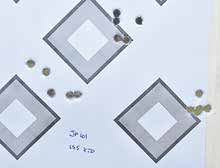
Smith & Wesson revolver cylinders release by pushing the button forward, Colt by pulling to the rear, and Ruger by pushing in toward the hammer. The firing pin is frame mounted. There is a transfer-bar safety that must be raised up by the trigger before the hammer can drive the transfer bar into the firing pin, thereby firing the cartridge. Most cylinders are secured in the frame window via contact points with the breech face and the bolt. Frequently, a third point of contact is made at the front of the extractor rod. The SP101 instead adds a plate that pivots forward from the yoke into the frame, providing a very solid lockup.
The Ruger SP101’s rear sight is the standard groove in the top strap. The front sight, however, is a separate blued piece that is held in place by a roll pin and can be changed.
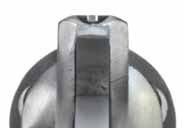
Required trigger compression was more than 12 pounds, as it was for the Model 60. Once we got used to the trigger, the SP101 shot a couple of great groups.
Our Team Said: Overall, the SP101 won the accuracy test, but only by a few hundredths of an inch over the used and aged S&W. The extra half-inch on the barrel actually provided a bit more velocity and the energy that goes with that. The extra weight made this the most comfortable of the three wheelguns to shoot. The sights consistently shot slightly high and right, though they were still just fine for defensive work.
Bottom Line
In our tests, the SIG Sauer P365 shot more quickly, was a bit easier to shoot accurately, recoiled a bit less, concealed more easily, and carried a higher round count of somewhat more powerful ammunition. It would appear that we have destroyed our own argument about the viability of the snub-nosed revolver in the modern shooting world, except in the areas of dependability and simplicity of deployment. We believe those are important considerations. To wit:
Semi-automatic pistols are more likely to malfunction than revolvers. Making sure your Pocket 9 is well-maintained will mitigate a large percentage of potential problems. If it does jam, a little bit of training and a solid “Slap, Rack, Bang” will fix most of the things that can go wrong. With the revolver, however, simply pull the trigger again.
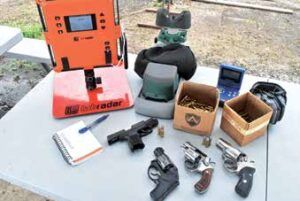
Semi-autos can be more sensitive to ammunition selection and fundamentals of grip and stance. Don’t lock the arms out, and the auto can malfunction. Feed it the wrong ammo, and it can malfunction. The revolver doesn’t care if you put five different kinds of old ammo in there. If it doesn’t work, press the trigger again. We have done many demos where we held the revolver upside down and activated the trigger with our little finger. We are less likely to be accurate, of course, but the revolver didn’t care.
Many law-enforcement officers carry a small revolver in an ankle holster. Yeah, ankle holsters are itchy and uncomfortable when you first wear them, but so are inside-the-waistband holsters. That ankle holster leaves the backup gun down close to the dirt. Do an informal survey sometime and ask police officers whether they are willing to trust their lives to a semi-auto or a revolver that is likely to get dirty. A quick note on the ankle holster for the average citizen — they work very well for someone who drives a lot. Puts that handgun in an accessible location.
Those with less-than-optimal hand strength may find the semi-auto slide hard to rack and the manual of arms more difficult to perform. The operating procedures on the revolver are simple and few — open the cylinder, load the cylinder, close the cylinder, press trigger. We readily acknowledge that those with diminished hand strength might also find issue with the longer, and frequently heavier, trigger pull required from the revolver.
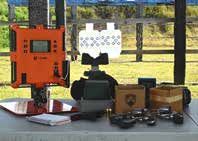
What if you have the semi-auto in a purse or coat pocket with an absolute need to shoot and no time to draw? Press the trigger. In all likelihood, you will get one shot off before the slide fouls in the pocket and the gun malfunctions. The revolver doesn’t care. Press the trigger again as necessary.
If, heaven forbid, a good guy or gal has to defend themselves at contact distance, pushing the muzzle of a semi-auto into the attacker will force the slide to the rear, rendering the pistol inoperable until that condition is remedied. The revolver doesn’t care. Press the trigger again as necessary.
Is the small revolver the perfect everyday carry gun? No. The snubnosed 38 Special is a tool, a specialized tool, that does some jobs better than just about any other choice. Several of our test group carry Pocket Nines on a daily basis, especially during the summer in Houston. We have no intention of giving them up. But when it gets cold, we carry a 38 Special in a coat pocket because we don’t have time to dig through the other layers to get to the pistol on our belt.
When we carry a second handgun, we carry a 38 Special. When we drive a lot, we carry a 38 Special. We know tons of ladies who carry them in their purses and quite a few other folks that carry a 38 Special off body in a briefcase. We have no intention of trading in our snubbies, but we do realize their increasingly specialized role in concealed carry.
Drill Data (5x9x7)
| Pistol | Time to First Shot (seconds) | Split Average (seconds) | Total Time (seconds) |
|---|---|---|---|
| SIG Sauer P365 9mm Luger | 0.83 | 0.21 | 1.68 |
| S&W Model 60 38 Special | 0.9 | 0.28 | 2.03 |
| Ruger LCR 38 Special | 0.87 | 0.27 | 1.94 |
| Ruger SP101 38 Special | 0.87 | 0.28 | 1.98 |
38 Special Range Data
| Hunter’s Supply 125-grain Lead | S&W Model 60 | Ruger LCR | Ruger SP101 |
| Average Velocity | 792 fps | 790 fps | 820 fps |
| Muzzle Energy | 174 ft.-lbs. | 173 ft.-lbs. | 187 ft.-lbs. |
| Best Group | 1.32 in. | 1.79 in. | 1.38 in. |
| Average Group | 1.62 in. | 2.39 in. | 1.69 in. |
| Hornady 125-grain XTP | S&W Model 60 | Ruger LCR | Ruger SP101 |
| Average Velocity | 827 fps | 842 fps | 863 fps |
| Muzzle Energy | 190 ft.-lbs. | 197 ft.-lbs. | 207 ft.-lbs. |
| Best Group | 1.23 in. | 1.98 in. | 0.61 in. |
| Average Group | 1.34 in. | 2.33 in. | 1.16 in. |
Testing was done at American Shooting Centers in west Houston. Muzzle velocities were determined via a LabRadar chronograph ($559). All shots for group were fired double action from a well-sandbagged Caldwell Pistol Rest from MidwayUSA and aided by a mini-DRC Fortune Cookie bag from Wiebad.com.


























